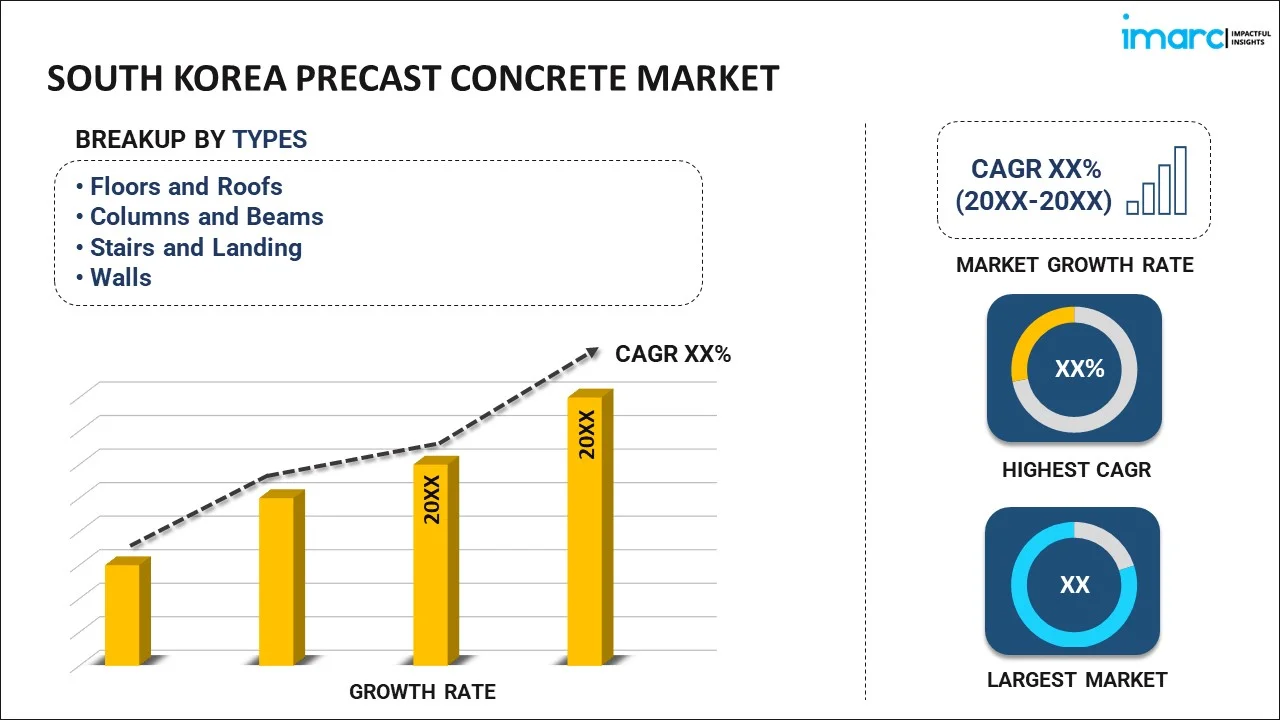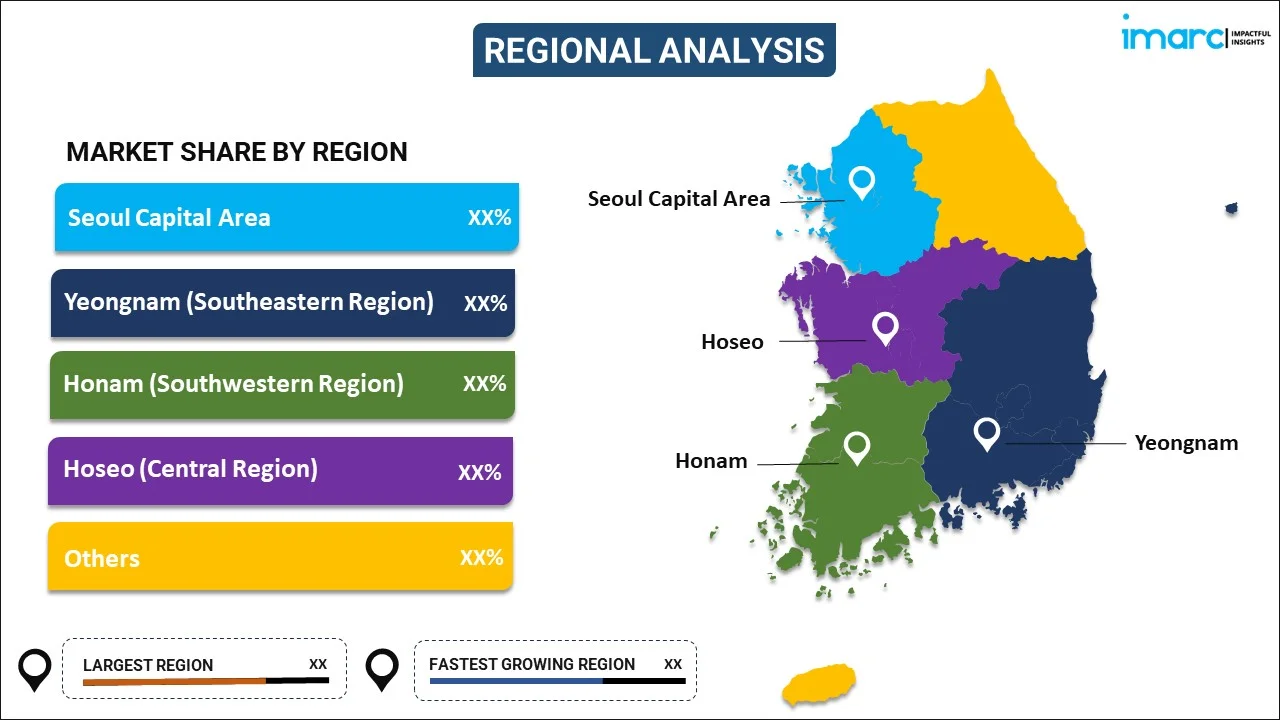
South Korea Precast Concrete Market Report by Type (Floors and Roofs, Columns and Beams, Stairs and Landing, Walls), Product (Structural Building Components, Architectural Building Components, Transportation Products, Water and Waste Handling Products, and Others), End Use (Residential, Non-Residential), and Region 2025-2033
Market Overview:
South Korea precast concrete market size reached USD 2,561.4 Million in 2024. Looking forward, IMARC Group expects the market to reach USD 3,810.5 Million by 2033, exhibiting a growth rate (CAGR) of 4.5% during 2025-2033. The increasing urbanization and a growing regional population, which enhance demand for infrastructure development, including residential, commercial, and industrial construction projects, is driving the market.
|
Report Attribute
|
Key Statistics
|
|---|---|
|
Base Year
|
2024
|
|
Forecast Years
|
2025-2033
|
|
Historical Years
|
2019-2024
|
| Market Size in 2024 | USD 2,561.4 Million |
| Market Forecast in 2033 | USD 3,810.5 Million |
| Market Growth Rate 2025-2033 | 4.5% |
Precast concrete is a construction material produced by casting concrete in reusable molds or forms at a centralized facility rather than on-site. This method allows for the creation of standardized and high-quality structural components, such as beams, columns, walls, and slabs, in a controlled environment. The process involves preparing the molds, pouring concrete into them, curing the material, and then transporting the finished components to the construction site for assembly. Precast concrete offers several advantages, including increased efficiency, consistency, and durability. It reduces construction time, minimizes waste, and ensures a more reliable and uniform product. Precast concrete is widely used in various construction applications, contributing to efficient and cost-effective building practices.
South Korea Precast Concrete Market Trends:
The precast concrete market in South Korea is experiencing robust growth, primarily propelled by a confluence of key drivers. Firstly, the escalating demand for rapid construction solutions has ignited the market's upward trajectory. As urbanization continues to accelerate regionally, the need for efficient and time-sensitive construction methods has become imperative, positioning precast concrete as an ideal solution for meeting stringent project timelines. Moreover, the increasing emphasis on sustainable and eco-friendly construction practices has significantly contributed to the market's expansion. Precast concrete's inherent qualities, such as reduced waste generation and lower environmental impact during manufacturing, align seamlessly with the growing trend toward green construction. This alignment has not only bolstered the market's attractiveness but also positioned it as a pivotal player in fostering environmentally conscious building practices. Furthermore, the advancements in technology and innovation have played a pivotal role in enhancing the efficiency and versatility of precast concrete solutions. The integration of cutting-edge manufacturing processes, coupled with digital design tools, has enabled architects and builders to explore innovative designs while maintaining precision and cost-effectiveness. This technological impetus has driven a surge in the adoption of precast concrete across diverse construction projects, further solidifying its position as a key player in the construction industry's evolution. In essence, the regional precast concrete market is thriving on a synergistic interplay of rapid construction demands, sustainability imperatives, and technological advancements.
South Korea Precast Concrete Market Segmentation:
IMARC Group provides an analysis of the key trends in each segment of the market, along with forecasts at the country level for 2025-2033. Our report has categorized the market based on type, product, and end use.
Type Insights:

- Floors and Roofs
- Columns and Beams
- Stairs and Landing
- Walls
The report has provided a detailed breakup and analysis of the market based on the type. This includes floors and roofs, columns and beams, stairs and landing, and walls.
Product Insights:
- Structural Building Components
- Architectural Building Components
- Transportation Products
- Water and Waste Handling Products
- Others
A detailed breakup and analysis of the market based on the product have also been provided in the report. This includes structural building components, architectural building components, transportation products, water and waste handling products, and others.
End Use Insights:
- Residential
- Non-Residential
The report has provided a detailed breakup and analysis of the market based on the end use. This includes residential and non-residential.
Regional Insights:

- Seoul Capital Area
- Yeongnam (Southeastern Region)
- Honam (Southwestern Region)
- Hoseo (Central Region)
- Others
The report has also provided a comprehensive analysis of all the major regional markets, which include Seoul Capital Area, Yeongnam (Southeastern Region), Honam (Southwestern Region), Hoseo (Central Region), and others.
Competitive Landscape:
The market research report has also provided a comprehensive analysis of the competitive landscape in the market. Competitive analysis such as market structure, key player positioning, top winning strategies, competitive dashboard, and company evaluation quadrant has been covered in the report. Also, detailed profiles of all major companies have been provided.
South Korea Precast Concrete Market Report Coverage:
| Report Features | Details |
|---|---|
| Base Year of the Analysis | 2024 |
| Historical Period | 2019-2024 |
| Forecast Period | 2025-2033 |
| Units | Million USD |
| Scope of the Report | Exploration of Historical and Forecast Trends, Industry Catalysts and Challenges, Segment-Wise Historical and Predictive Market Assessment:
|
| Types Covered | Floors and Roofs, Columns and Beams, Stairs and Landing, Walls |
| Products Covered | Structural Building Components, Architectural Building Components, Transportation Products, Water and Waste Handling Products, Others |
| End Uses Covered | Residential, Non-Residential |
| Regions Covered | Seoul Capital Area, Yeongnam (Southeastern Region), Honam (Southwestern Region), Hoseo (Central Region), Others |
| Customization Scope | 10% Free Customization |
| Post-Sale Analyst Support | 10-12 Weeks |
| Delivery Format | PDF and Excel through Email (We can also provide the editable version of the report in PPT/Word format on special request) |
Key Questions Answered in This Report:
- How has the South Korea precast concrete market performed so far and how will it perform in the coming years?
- What has been the impact of COVID-19 on the South Korea precast concrete market?
- What is the breakup of the South Korea precast concrete market on the basis of type?
- What is the breakup of the South Korea precast concrete market on the basis of product?
- What is the breakup of the South Korea precast concrete market on the basis of end use?
- What are the various stages in the value chain of the South Korea precast concrete market?
- What are the key driving factors and challenges in the South Korea precast concrete?
- What is the structure of the South Korea precast concrete market and who are the key players?
- What is the degree of competition in the South Korea precast concrete market?
Key Benefits for Stakeholders:
- IMARC’s industry report offers a comprehensive quantitative analysis of various market segments, historical and current market trends, market forecasts, and dynamics of the South Korea precast concrete market from 2019-2033.
- The research report provides the latest information on the market drivers, challenges, and opportunities in the South Korea precast concrete market.
- Porter's five forces analysis assist stakeholders in assessing the impact of new entrants, competitive rivalry, supplier power, buyer power, and the threat of substitution. It helps stakeholders to analyze the level of competition within the South Korea precast concrete industry and its attractiveness.
- Competitive landscape allows stakeholders to understand their competitive environment and provides an insight into the current positions of key players in the market.
Need more help?
- Speak to our experienced analysts for insights on the current market scenarios.
- Include additional segments and countries to customize the report as per your requirement.
- Gain an unparalleled competitive advantage in your domain by understanding how to utilize the report and positively impacting your operations and revenue.
- For further assistance, please connect with our analysts.
 Request Customization
Request Customization
 Speak to an Analyst
Speak to an Analyst
 Request Brochure
Request Brochure
 Inquire Before Buying
Inquire Before Buying




.webp)




.webp)












